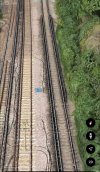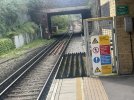Do all trains have retractable shoegear?
Yes, but in the sense that it possible to lift the shoegear out of the way on every train that runs on DC power from the third rail, even if it has to be done manually. On most DC-only units, the shoes are held down against the top of the 3rd rail by spring pressure, so you have to lift the shoes manually against the spring pressure using a wooden paddle then strap them in the raised position using a cable tie or something.
On most dual voltage units like the 377/2s, /5s and /7s, or 387s, the shoes are held against the top of the 3rd rail using main reservoir air pressure, and are retracted by spring pressure when the AC system is selected which cuts off the main res air supply to the shoegear - the spring is therefore acting in the opposite way to that on the DC-only unit, forcing the shoes up instead of down. This also has the benefit of raising the shoes if the unit loses main res air pressure due to a burst.
On some dual voltage units (e.g. 319s) the shoes remain in the lowered position when in AC mode.


